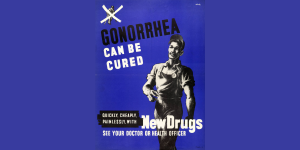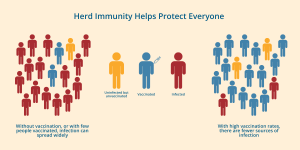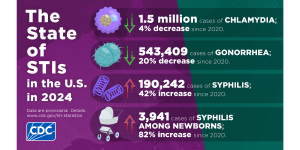
Antibiotic-Resistant Gonorrhea is On the Rise Globally
A new report from the World Health Organization (WHO) warns of rising levels of drug-resistant gonorrhea. The data comes from reported cases of gonorrhea in 12 countries across five WHO regions.
Crabs:
Fast Facts
Most cases of crabs happen as a result of intimate contact, when crabs move from the pubic hair of one person to the pubic hair of another. Even when there is no sexual penetration, you can get crabs or give them to someone else if you’re in close physical contact—whenever some part of your body that has coarse hair (such as the pubic area, eyelashes, eyebrows, facial hair, chest, or armpits) comes into contact with the another person’s infested pubic or other course hair. Crabs do not usually attach to head hair.
Crabs can also be passed on in non-sexual ways. For example, it is possible for a person can get crabs from sleeping in an infested bed, using infested towels, or wearing infested clothing. Toilets seats? While not entirely impossible, getting crabs this way would be extremely rare. Not only is the surface of a toilet seat to smooth for crabs to hold on to, but they also don’t live long away from a human body.
The most noticeable symptom is often intense itching that usually starts about 5 days after a person gets crabs. This itching is caused by an allergic reaction to the bites.
A person may be able to see individual crabs by looking closely or using a magnifying glass. Crabs are small parasites that resemble crabs you see on the beach. They may be whitish-gray or rust colored.
A person may also notice crab eggs—or nits—attached to the base of the hair (close to where it comes out of your body). Nits are small, oval-shaped and pearl-like in color. Dark or bluish spots can appear and last for several days in the infested area; these are also a result of the bites.
Crabs are usually found in the pubic area. However, crabs can also be found in the armpits, eyelashes, beard/mustache and other course hair. Crabs are only very rarely found in the hair on a person’s head.
Crabs, in general, don’t cause anything more than discomfort and inconvenience. Occasionally, secondary bacterial infections may occur due to aggressive scratching.
You can usually see the crabs yourself if you look closely enough. You might need a magnifying glass to help you identify them. If you are uncertain, have a healthcare provider examine you. He or she may need to use a microscope.
Recommended treatments for crabs include:
Permethrin cream
Lindane shampoo (Kwell®)
NOTE: Lindane (Kwell®) is potentially harmful and may cause central nervous system complications, even though no problems have been known to occur in treatments limited to the recommended 4-minute period.
Pyrethrins with piperonyl butoxide
For infested eyelids and eyebrows an ointment is available by prescription.
Even if treatment is successful, you may still have some itching as a result of a skin irritation or allergic reaction. If so, you can use hydrocortisone cream to help stop the itching.
If you find out you have crabs, it is important that you talk to your partner or partners as soon as you can so they can get treatment. It is possible to pass crabs back and forth. If you get treated and your partner doesn’t, you may get infected again.

A new report from the World Health Organization (WHO) warns of rising levels of drug-resistant gonorrhea. The data comes from reported cases of gonorrhea in 12 countries across five WHO regions.

We’ve known for years that the HPV vaccine works. Now new research shows that widespread vaccination even protects those who haven’t gotten the shot. This study proves that it is possible to reach herd immunity for HPV.

HPV is one of the most common sexually transmitted infections. Still, finding out that you or your partner has it can feel stressful and confusing. It’s normal to have a lot of questions: What does this mean for our health? Did someone cheat? Should we

The CDC just released STI Surveillance Data for 2024 that show cases of chlamydia, gonorrhea, and syphilis are slowly declining.

Experts say that vaccinating newborns against hepatitis B is one of the most important things we do to protect infants.

Hepatitis is an inflammation of the liver that can be caused by a group of viruses—hepatitis A, B, C, D and E. When hepatitis viruses damage liver cells, scar tissue is formed and those cells can no longer function.

Explore ways to make sex safer and communicate with your sexual partners about your expectations and boundaries.

Why are STI rates so high among young people? For insight we chatted with Dr. J. Dennis Fortenberry, a Professor in the Department of Pediatrics at the Indiana University School of Medicine.
ASHA believes that all people have the right to the information and services that will help them to have optimum sexual health. We envision a time when stigma is no longer associated with sexual health and our nation is united in its belief that sexuality is a normal, healthy, and positive aspect of human life.
ABOUT
GET INVOLVED
ASHA WEBSITES
GET HELP
© 2025 American Sexual Health Association